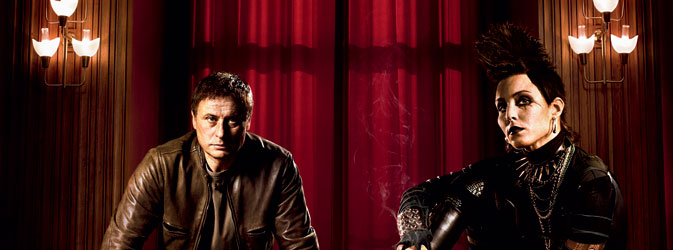
The final film based on Stieg Larsson’s Millennium Trilogy, more casually known as The Girl with the Dragon Tattoo series, goes out with a whimper instead of a bang. The Girl Who Kicked the Hornet’s Nest picks up immediately where The Girl Who Played with Fire left off, transforming the taut, action-packed murder mystery into a conspiratorial courtroom drama that feels far less urgent and compelling than it ought to.
The movie is not plodding by any means. On the contrary, it moves with the speed of something that has been highly compressed and streamlined, jumping from one scene to another. The places it goes, however, generally are not as intriguing as the situation in the first film, or as exciting and dangerous as those from the second. The subplots have been admirably pared down and repurposed to serve the main plot thread, creating a much more focused narrative than the book offers at the expense of some subtlety and complexity.
The film opens with Lisbeth Salander, computer hacker extraordinaire and the titular hornet-kicker, recovering from a bullet to the brain which she incurred while trying to murder her evil father with an axe.
The story’s centerpiece is the courtroom drama where Salander is tried for the attempted murder of her father, and the two forces trying to influence the trial’s outcome. On one side, you have Blomkvist, the staff of Millennium magazine and Salander’s hacker friend struggling to gain evidence to clear her name and restore her legal rights. Meanwhile, the Cold War spooks try to get her re-committed to a mental institution to cover their own embarrassing involvement with her criminal father, who was a soviet defector.
I cannot imagine trying to make sense of the film’s opening without seeing the first two films or having read the books. Without understanding why Salander was trying to kill her father or how Blomkvist got access to the classified information about her criminal father, the beginning of the movie is nearly incoherent.
However, as the plot progresses, it almost exclusively focuses on events that occurred in the first two movies. The trial scene summarizes the injustices Salander has suffered throughout her life, which readers and movie-goers will already be familiar with. There is a satisfying, if predictable finale as well where Salander faces off against her Frankensteinian half-brother.
Larsson’s books have always been triumphs of brilliant characterization over plotting or prose and that has never more evident than it is in the unevenly paced final installment of the series. Fortunately, the film’s casting is nearly perfect. Noomi Rapace reprises her role as the acerbic but brilliant Salander and Michael Nyqvist returns as investigative journalist Mikael Blomkvist.
In addition to looking like she was born for the part, Rapace has a wonderful fierceness that allows her to speak volumes through Salander’s hostile silences. Nyqvist comes off as a subdued Daniel Craig, which is fitting since Blomkvist’s character is something akin to a humble, amateur James Bond. Annika Hallin returns as Blomkvist’s sister, Annika Giannini, and does admirably with her larger role as Salander’s defense attorney.
Strong as the casting is however, so much of Larsson’s characters are lost without access to their thoughts. Their carefully strategized plans are rendered invisible or simplified for the sake of narrative clarity.
The other journalists at Millennium Magazine and all of the government agents, both good and bad, are under-developed. The main villain of the film, Dr. Peter Teleborian, loses much of the condescension that made him so loathsome in the book, and he comes across as a much more generic creep as a result.
Even Salander, despite Rapace’s nuanced performance, feels short-changed by the transition to film. Indeed, if Rapace was a weaker actress, the movie would completely fall apart.
That said the movie does manage to improve on the book in certain areas. Larsson’s greatest short-coming as an author is unquestionably his tendency to indulge in meticulous exposition about the intricacies of economics and Swedish law and politics. The movie completely skips the torturously detailed backstory about the Cold War spooks that drags out the beginning of the novel. Salander’s jaunt to Gibraltar following her trial is also thankfully absent from the film, resulting in a stronger, more focused conclusion to the narrative than in the book.
The movie has some fun moments, and a couple of gripping scenes but ultimately lacks the sort of dramatic momentum one expects from a thriller.
If you have read or watched both The Girl with the Dragon Tattoo and The Girl Who Played with Fire, you owe it to yourself to see Lisebth Salander’s saga through to the end. If not, you would be better served by watching either of the earlier chapters first.
